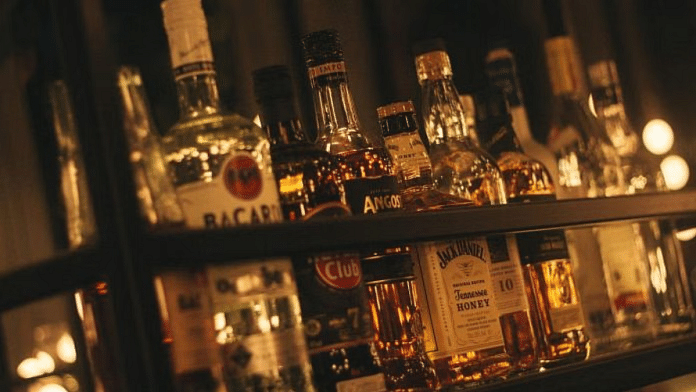Gurugram: The Haryana government has unveiled its Excise Policy for 2025-27, which would result in a moderate increase in liquor prices across the state, driven by revised ex-distillery prices and enhanced license fees, particularly in urban hubs like Gurugram and Faridabad.
The policy, effective from 12 June 2025 to 31 March 2027, aims to boost revenue, curb illicit liquor trade, and promote responsible drinking while navigating the delicate balance between economic goals and social considerations.
This adjustment—the policy spans a duration of 22 months instead of the usual 12 months—addresses the misalignment in previous excise policies which would typically ran from June to May instead of the normal April to March cycle, creating administrative and accounting challenges.
The misalignment crept in Haryana’s policy because of the closure of liquor vends for two months during the COVID-19 pandemic in 2020. By extending the policy to 31 March 2027, the state aims to streamline revenue collection, budgeting, and compliance processes, ensuring they are in sync with the financial year framework, says the policy document.
The new excise policy introduces higher ex-distillery prices—the price at which the distillery sells the liquor to wholesalers—for country liquor which will inevitably translate into costlier bottles for consumers. For instance, the ex-distillery price for country liquor (50-degree proof) in new glass bottles rises from Rs 360 per case (quarts) in 2025-26 to Rs 370 in 2026-27, with similar increments for pints and nips.
The 65-degree proof “Metro Liquor” sees a steeper hike, with new glass bottle quarts moving from Rs 410 to Rs 420 per case over the same period. These adjustments, coupled with value-added tax (VAT) at 12 percent plus a 5 percent surcharge, are expected to push retail prices up by 5-7 percent for country liquor and marginally for Indian Made Foreign Liquor (IMFL) in most districts.
In Gurugram and Faridabad, the impact will be more pronounced due to higher license fees for bars and taverns. Bars in these districts face a license fee of Rs 45 lakh annually, compared to Rs 35 lakh in Panchkula and Sonepat, and Rs 23 lakh elsewhere.
Tavern fees in Gurugram are pegged at 4 percent of the zone’s license fee, the highest in the state, potentially leading to increased prices at upscale establishments.
Also, the extended bar hours (up to 2 am) in these cities come with hefty fees—Rs 20 lakh in 2025-26, rising to Rs 25 lakh in 2026-27—likely to be passed on to patrons, making nightlife costlier.
The Excise Policy 2025-27 is designed to maximise government revenue while addressing the challenges posed by neighboring states, with 21 of Haryana’s 22 districts sharing borders.
The state has set a cap of 2,400 retail liquor vends (L-2/L-14A) and introduced stringent regulations to ensure transparency, curb cartelisation, and promote ease of doing business.
The policy aligns the excise year with the financial year, a move aimed at streamlining operations.
“We’ve crafted a policy that not only secures optimal revenue but also ensures a fair and transparent system for all stakeholders—government, manufacturers, licensees, and consumers,” said Excise and Taxation Commissioner Vinay Pratap Singh under whose name the policy has been released.
He highlighted measures like e-tendering for vend allotments, mandatory POS machines for billing, and geo-tagging of vends to enhance accountability.
Also Read: Joint venture clause to family shareholdings, what CAG report on Delhi excise policy flagged
Gurugram and Faridabad
Gurugram and Faridabad, the state’s economic powerhouses, are singled out for their high revenue potential. The policy incentivises upscale “Avant-Garde Outlets” in posh markets or malls, where licensees can sell only IMFL in air-conditioned, well-decorated shops with vitrified flooring and systematic brand displays.
These outlets, requiring a zone license fee of Rs 15 crore or more, are entitled to an additional 5 percent quota without extra excise duty, potentially increasing IMFL availability but at a premium price.
The policy balances revenue goals with social responsibility. No liquor vends are permitted within 150 meters of schools, colleges, bus stands, or places of worship, though the Excise Commissioner can relax this to 75 meters in urban areas. Vends are banned near National or State Highways (within 500 meters, reduced to 220 meters in smaller towns) and in villages with gurukuls or populations below 500. Holy towns like Thanesar, Pehowa, and the Shri Mata Mansa Devi Temple area in Panchkula remain vend-free zones.
To curb public drinking, the policy promotes taverns for on-premises consumption, restricted to urban and suburban areas within 5 km of municipal limits or industrial townships.
Only one tavern per retail zone is allowed, with fees varying by district—4 percent of the zone’s license fee in Gurugram, 3 percent in Faridabad, and 1 percent elsewhere. Rural vends in villages with over 10,000 people can operate a snack bar for Rs. 1 lakh, encouraging controlled consumption.
To combat spurious liquor, the policy mandates holograms, QR code-based track-and-trace systems, and CCTV cameras at distilleries, breweries, bottling plants, and urban vends.
Flow meters monitor extra neutral alcohol (ENA) production, and an enforcement wing, including police on deputation, will target illegal sales and transportation. Penalties for violations are steep—Rs 50,000 for selling expired liquor, escalating to Rs 1 lakh for repeat offenses—and license cancellation for major breaches like selling unaccounted liquor.
The policy encourages consumption of low-alcohol beverages like wine, beer, and cider. Local wineries benefit from a low license fee of Rs 20,000 for retail sales and Rs 5,000 for wine taverns.
Microbreweries, with a cap on alcohol content at 8 percent by volume, are promoted in urban centers, while corporate offices with over 5,000 employees can obtain a license for Rs 10 lakh to serve low-alcohol drinks in canteens.
(Edited by Ajeet Tiwari)
Also Read: Alcoholic beverage industry wants inflation-linked pricing model to offset rising input costs






